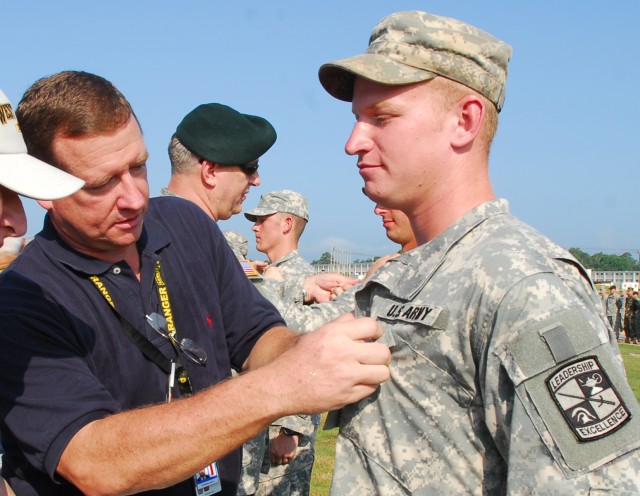Kristin Molinaro, The Bayonet
When LTC John L. Erickson jumped out of a C-47 above Corregidor at just after 8:30 a.m. Feb. 16, 1945, he stepped into history as the first American paratrooper out the door in the effort to reclaim the island during World War II.
Though the history lesson may no longer be a part of Fort BenningAca,!a,,cs Advanced Infantry Officers Class, in the late 1940s it was a story many officers learned, according to curriculum from the course taught by CPT Donald Crawford from 1948-1949.
Four generations later, EricksonAca,!a,,cs descendants are still taking to the skies.
Cadet John Cochran, the great-grandson of Erickson, earned his Airborne wings Friday at a graduation ceremony held on Eubanks Field.
Aca,!A"That kind of family legacy is more valuable than gold,Aca,!A? said MG Michael Ferriter, commanding general of Fort Benning, of the family during his speech to the graduating class from C Company, 1st Battalion (Airborne), 507th Parachute Infantry Regiment.
The ceremony coincided with the 69th anniversary of the first Airborne test platoon jump in 1941 that paved the way for Airborne operations.
On hand to pin CochranAca,!a,,cs wings were his father, LTC(R) Lewis Cochran, and grandfathers, MG(R) James Francis and COL(R) Frank Casey, who attended Airborne School at Fort Benning during their Army careers.
The family legacy began when Erickson commanded the 3rd Battalion, 503rd Parachute Regimental Combat Team, and led troops into battle to reclaim the island of Corregidor three years later after the U.S. surrendered it to Japanese troops in 1942, said his son-in-law, Casey.
Erickson died in 1967 but his stories of that day live on through his family.
The troops landed on a drop zone, Erickson described to Casey as Aca,!A"like jumping onto a dime.Aca,!A?
The troops faced winds between 16-18 knots per hour, roughly 19-20 miles per hour, as they attempted to land on one of two small drop zones on the island, according to the 503rd PRCTAca,!a,,cs Heritage Web site at http://corregidor.org.
Aca,!A"They only let three Soldiers jump on each pass from each door,Aca,!A? said Casey. Aca,!A"The aircraft made circles until they were fully unloaded. But even with only three jumping, they still didnAca,!a,,ct hit the drop zone. Some landed on the cliffs, some were blown into the ocean. It was a difficult jump.Aca,!A?
Karen Cochran, EricksonAca,!a,,cs granddaughter and mother to John Cochran, recalled looking at mementos her grandfather kept from his time at Corregidor.
In a box along with pictures of the island, there was Aca,!A"a whiskey bottle that all the paratroopers had signed and written comments on from the jump onto Corregidor,Aca,!A? she said.
The youngest Cochran paratrooper, John, said he couldnAca,!a,,ct imagine the conditions his great-grandfather faced, but hopes to live up to the legacy three generations have built upon.
Aca,!A"They inspired me,Aca,!A? said John, the oldest of four brothers. Aca,!A"As I grew older and saw the importance of certain things they did, I wanted to emulate them. I get to wear the wings they wore and gave honor to.Aca,!A?
JohnAca,!a,,cs father said he first saw his sonAca,!a,,cs interest in the Army when John began working at the Conus Replacement Center doing odd jobs after graduating high school.
Aca,!A"He was working with a bunch of old NCOs and was inspired by their example,Aca,!A? said the elder Cochran, who retired from the Army in 2001.
Shortly thereafter, John enrolled in ROTC at Columbus State University to pursue his goal of becoming an Army Infantry officer.
He is now majoring in political science and is looking forward to attending the Infantry Officer Basic Course and Ranger School.
Aca,!A"This is just the beginning of a lot of things I (hope to) accomplish,Aca,!A? he said.


Social Sharing